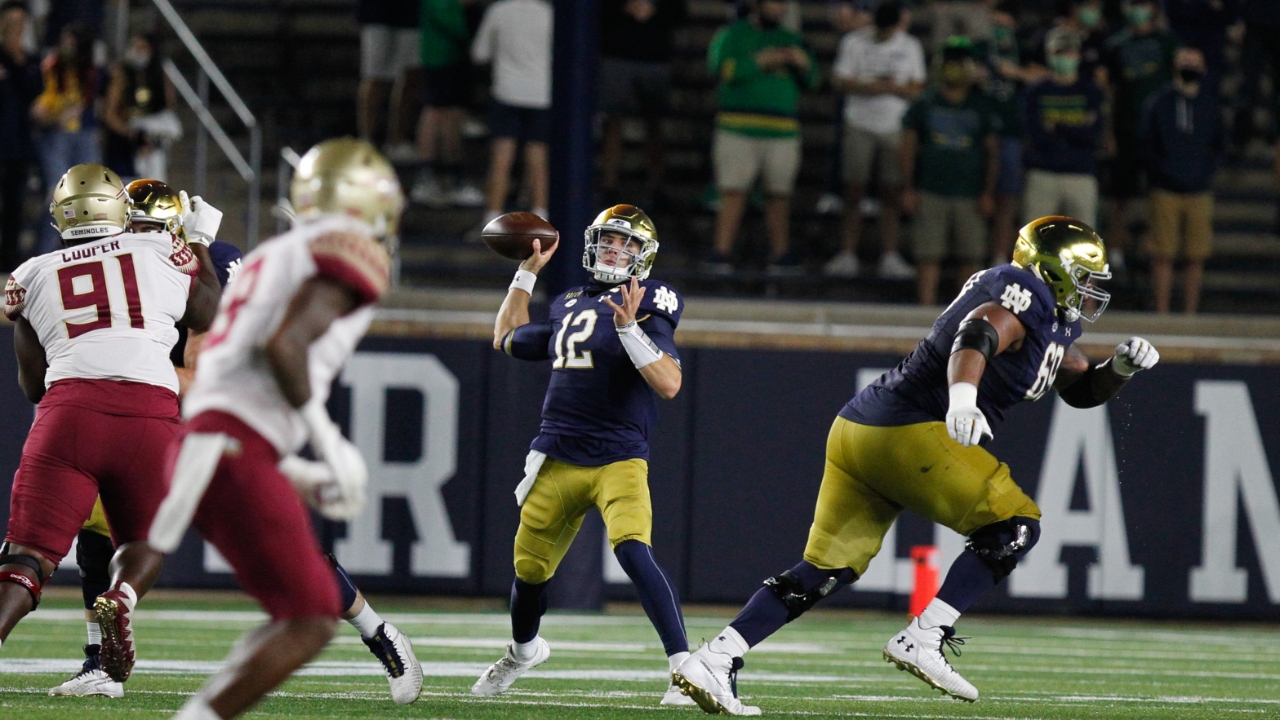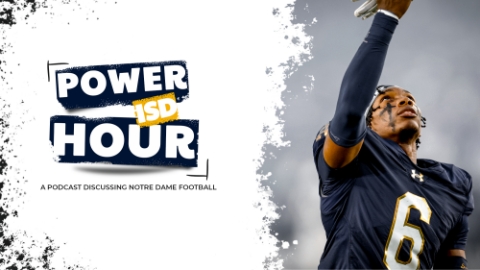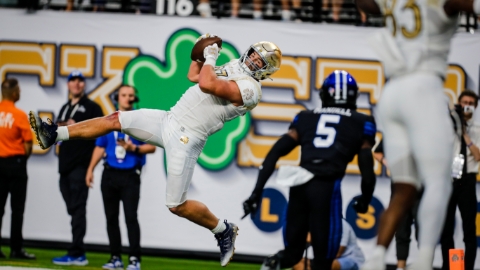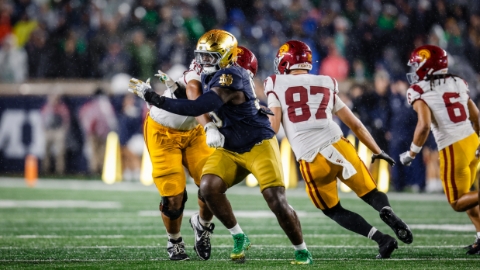Inside The Headset | Notre Dame, Rees Used Balanced Attack To Blow Out FSU

After breaking down much of Notre Dame’s offensive film from the 2019 season last offseason, Coach Sting is back, taking a look at Tommy Rees and the Irish offense’s performance in 2020.
You can check out Coach Sting’s work last season HERE.
In addition to the win over the Seminoles, Coach Sting will be examining both matchups against Clemson.
It is a pleasure to be back and I am looking forward to taking a closer look at Tommy Rees and Notre Dame’s overall offensive approach in three games from 2020.
I started with the 42-point offensive outburst against Florida State, where the Irish offense was methodical in their attack and clearly had some great intel during their scouting on what defenses to expect. Let’s take a look at some instances and numbers that led to this performance.
Playing an ACC schedule in 2020 meant Notre Dame’s offense would be facing defenses unaccustomed to offenses that featured the tight so prominently. Clemson notwithstanding (and we will dive into both of those games next), ACC defenses are not built with enough heavy defensive personnel to match this attack.
Notre Dame had 69 snaps on offense versus Florida State and utilized at least one TE/H type player on all but 3 plays.
A while back, while deep-diving into certain plays, we went over how defenses identify offensive personnel. Typically, defensive coordinators will make sub-packages and defensive calls based on the offensive personnel on the field. This is easily communicated through 2 numbers, the first being the number of RB’s and the second number being the number of TE’s.
Therefore, “12” personnel would be 1 RB and 2 TE’s, assuming the remaining personnel on the field are 5 OL, 1 QB, and 2 WR’s.
Notre Dame’s approach versus Florida State actually included the use of 2 TE’s 38 times, including 13 personnel a total of 13 times! In today’s world of modern football, those numbers are rarer than you may think, especially in the 10 personnel world that is ACC football (think Louisville, Duke, UNC, Miami and FSU).
There are ACC teams that do use 1 TE from time to time, but it is rare they utilize more than one. Moreover, it is important to note the way ACC tight ends tend to be used more traditionally; either “in-line” next to the tackle or in the “sniffer” or “H-back” position, lined up one yard back and one yard inside or outside the TE.
Here is where Notre Dame differs, especially in this game versus Florida State. Not only do they use multiple TE’s, it’s the way they use them that really stands out. Then again, not everyone has a Tommy Tremble.
Tremble lined up at an astounding 8 different spots (not including L/R) against the Seminoles! Rees kept 11 or 12 personnel on the field consistently, but not necessarily in traditional TE sets.
The defense couldn’t be sure if Tremble was going to line up as a true in-line TE, an H back, a fullback, a #3 WR (third WR from the outside-in), a slot, a wing (1-by-1 outside a TE) or even at outside WR. In addition, he did this left and right, as well as lined up in unbalanced formations.
All of this forced the Florida State defense to stay vanilla and not load up with heavy personnel, despite the use of these TE’s for the Irish.
Here is a good example early in the game on back-to-back plays.
On 1st and 10, the Irish featured 13 personnel, with Tremble, Michael Mayer, and Brock Wright. On 2nd and 7, Rees substituted #88 Javon McKinley for Wright, who is no little guy himself, standing at 6-2 215lbs.
The Irish have stuck to recruiting large bodies on offense and subscribe to the old Bill Parcells adage used at just about every position, “big people beat up little people.”
So, Rees dialed up this horizontal spacing concept, which is great versus zone coverage, as the Noles are in here:
This is a great example of giving Ian Book a rhythm throw that is read left to right and is as simple of a read as it gets, getting the ball out quickly to convert with a 14-yard pickup.
The Irish then hustle to the line of scrimmage with the same exact personnel and lineup with twin WR’s to the left and TE/Wing to the right (Mayer/Tremble). ND motions junior WR Braden Lenzy across the formation and FSU displaces their safety, as he follows Lenzy across the field, leaving a void in the defense pre-snap.
On this play, the Seminoles bring edge pressure to the open side without a safety behind the blitzing LB and the Irish capitalized with Kyren Williams taking it 46 yards to the end zone.
This play is a G/H counter and is a popular concept in college football today. The origins of this derive from the old Washington Counter Trey, where they would counter step the RB and pull the backside Guard and Tackle.
I will quickly illustrate why teams have run more G/H these days, as opposed to the traditional G/T Counter and it has everything to do with defenses. In the past, defensive ends would “stay home” and work their way up the field on just about every play. Therefore, when a tackle pulled, they really were never a threat to make the play from the backside.
These days, due to the advent of “Zone Read,” DE’s are more apt to chase down the line if they get a tackle on a “down” block. DE’s see a tackle pull on their side as a down block and can make the tackle on the ball-carrier.
To stay one step ahead, offenses now pull the guard, allow the tackle to block out, and “pull” an H back in place of the tackle. Having a solid blocker like Tremble, who is also athletic enough to find work in space, makes this play a real threat for Notre Dame.
This, coupled with FSU LB’s constantly stepping up (rather than reading pullers and matching) and safeties in really poor run-fits all game, made for a weapon for the Irish all game long. In fact, the GH counter accounted for 7 carries for 128 yards and 2 scores.
At first, it seemed Rees fell into the trap lots of OC’s fall into, wanting to use the entire playbook and being “afraid of success.” Meaning, if it is working - keep calling it until they can stop it. Such an easy concept to declare in pressers, yet so many play-callers are far different during games.
To Rees’ credit, he went back to this late in the second quarter and did exactly what you want to do as an offense, have the same concept presented in different ways for the defense. Easy for offense, looks complex for the defense.
Rees called 7 G/H counter out of 5 different formations, 3 personnel groupings, 3 different motions, and 2 of these were the QB version of G/H counter, with Book as the ball-carrier.
Taking it a step further, Rees also called “split-zone” 8 times for 109 yards. This is an inside zone play, plus taking the H back across the formation to block the backside.
Here you can see the first split-zone called by Rees in the second offensive series of the game, that went for 65 yards. Once again taking advantage of LB’s stepping up and bad safety fits.
Much like G/H counter in this gameplan, Rees dialed split-zone from 7 different formations, out of 11,12, & 13 personnel, including 3 different unbalanced formations, and even faked a reverse after handing off one of these.
All and all, anytime ND had an H-back work across and behind the formation on a run play (split-zone & G/H counter), they averaged 15.8 yards per carry on 15 carries.
This was a great job of scouting prior to the game and also recognizing what they were having success with in-game. Someone on the offensive staff got these numbers to Rees in a hurry and he went to it heavy in the end of the 2nd quarter and beginning of the 3rd.
On the front side of G/H counter, the ND OL was clearly coached-up vs blitz as well. When FSU brought pressure to the counter side, the down blocks of the PSG & PST “created a wall,” cutting off any run through LB’s to seal off lanes for the pullers and the RB.
Rees didn’t just have it rolling in the run game, he also put together a phenomenal plan in the pass game. Let’s take a look at 2 base concepts Rees called at almost perfect times.
First, “Mesh” is a popular Air Raid concept made famous by Mike Leech and his tree of coaches. In the Air Raid, it is called all the time versus just about every coverage, and that makes sense given the investment those teams have in the concept.
For teams like Notre Dame, who do not major in Mesh, there is one coverage that is ideal to dial up Mesh, that is working it versus “Man-Free” coverage, a 1-high safety coverage with man coverage underneath.
Usually this involves bringing one extra rusher (5 rushing, 6 in coverage) or in this case, FSU chooses to use the extra defender to spy Ian Book. All this means that there is not much of a rush and the “mesh” happens underneath vs the LB’s playing Man, whereas 2 WR’s cross each other really close, creating a rub on the Man defenders.
Rees calls Mesh 3 times during this game and all three happen to be vs. Man-Free. Book completed all 3 attempts for 25 yards, including an 8-yard TD strike to Mayer.
The second pass concept Rees went to five times this game is as old as forward pass - “Go deep,” a 4-vertical concept that has more detail and intricacies to it than its tag-line may suggest. This is a pass concept that is ideal versus 1-high coverages (4 verticals > 3 Deep in Coverage). This is also good when wanting to take a shot on the outside versus press man coverage.
Lastly, a lot of teams make sight adjustments on the outside if the CB’s bail, by breaking it off to stops/out routes. Sight adjustments require plenty of work to be on the same page, but ND executed this to perfection.
Generally speaking, regardless of where the receivers line up or what formation the offense is in, the landmarks for the four verticals are as follows: 5 yards from the boundary sideline, 2 yards outside the weak hash (old college hashmark), on the strong hashmark, and 5 yards from the field sideline.
I want to spend a minute highlighting the outside WR and particularly the second “4-Vertical” call that went to Javon McKinley for 37 yards.
The key on this route is to be sure to take an outside stem (running through the CB’s outside shoulder), but being careful not to bubble around the CB by running to the sideline. If McKinley runs outside immediately and does not leave room to the sideline, then Book would have no place to put the ball. Moreover, he would get pinned to the sideline and CB would be in perfect position to make a play on the football.
By running an outside stem with approximately 5 yards to the sideline, it is virtually impossible to defend if a good ball is thrown. The WR uses his body to shield the CB from the outside and the QB’s job is to drop the ball on the outside half of the WR.
It helps that McKinley is a big body and runs this route great, as you can see here. Later in the game, Rees dialed up a play-action out of 13 personnel and put McKinley on a skinny post to out-run all coverage - that did not go as well and seems more suited for a straight burner-type WR.
That aside, let’s focus on and take a look at McKinley’s beautiful vertical route that landed for a 37-yard gain.
All and all, Rees to went to 4 Verts five times this game, and Book was 3-5 (1 drop) for 77 yards. Much like the theme in the run game previously noted, Book did this out of multiple looks. He called it out of 4 different formations, had 2 different motions, and one flash fake (see above). Rees dialed this up versus one-high coverage two times, man-coverage twice and got caught in it versus a version of Cover 2 once, which was the only straight incompletion, with the other being a drop.
A key to success in the pass game that was possibly overlooked was the pass protection of running back Kyren Williams.
FSU brought 6-man pressures 12 times during the game. Out of these 12 snaps, the Irish ran the aforementioned GH counter twice (and ripped it vs pressure), 1 RB Screen that was set up well, but fell incomplete, 1 false start penalty, 7 drop-back passes, and one outside zone run at the end of the game.
Williams was phenomenal in these 7 dropbacks versus 6-man pressures. One could tell that even if a play-action was called, he would astutely disregard the fake and go right into pass-pro immediately. This is smart because if it is a 6-man pressure, it is Man coverage behind it (5 men left to cover = Man to man). With it being man coverage, they are looking at their man - or should be - and therefore a play action fake would be useless anyhow.
That combined with the urgency needed to pick up a blitz and protect the quarterback in a hurry during a blitz, it only makes sense for Williams to go right into pass pro mode.
More importantly, his technique and willingness to be great in pass protection allowed the Irish to make FSU pay versus 6-man blitz. In fact, Book was 6-7 for drop-back passes versus 6-man pressure, for 104 yards and a touchdown. A lot of that credit should go to Williams for keeping him upright during those plays.
This balanced attack against the Seminole defense included these run and pass concepts, but always seemed one step ahead and made lots of sense versus this Florida State personnel.
Next up, we will take a look at the plans Rees devised for two games against Clemson. Once we break those games down, I will try and go back and dig deeper into specific plays.
It was fun to get a chance to dig into a game like this to show how you just don’t score 42 points and control the entire game on offense by accident. A well thought-out gameplan, execution, and in-game adjustments are needed to put a full offensive attack together like this one.


